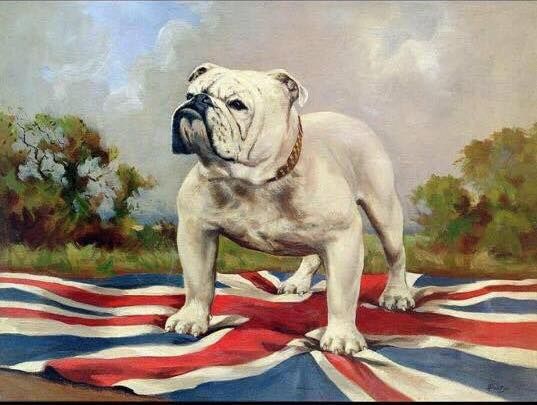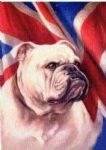Breed Standard

|
|
|
|
General Appearance: |
In forming a judgement on any specimen of the breed, the general appearance, which is the first impression the dog makes as a whole on the eye of the judge, should be first considered. Secondly should be noticed its size, shape and make, or rather its proportions in the relation they bear to each other. No point should be so much in excess of the others as to destroy the general symmetry, or make the dog appear deformed, or interfere with its powers of motion, etc. Thirdly its style, carriage, gait, temper and its several points should be considered separately in detail, due allowance being made for the bitch, which is not so grand nor as well developed as the dog. |
|
Characteristics: |
(See under General Appearance and Gait/Movement) |
|
Temperament: |
Should convey an impression of determination. |
|
Head and Skull: |
The skull should be very large - the larger the better - and in circumference should measure (round in front of the ears) at least the height of the dog at the shoulders. Viewed from the front it should appear very high from the corner of the lower jaw to the apex of the skull, and also very broad and square. The cheeks should be well rounded and extended sideways beyond the eyes. Viewed at the side, the head should appear very high, and very short from its back to the point of the nose. The forehead should be flat, neither prominent nor overhanging the face; the skin upon it and about the head very loose and well wrinkled. The projections of the frontal bones should be very prominent, broad, square and high, causing a deep and wide indentation between the eyes termed the "stop". From the "stop" a furrow both broad and deep should extend up to the middle of the skull, being traceable to the apex. The face, measured from the front of the cheek-bone to the nose, should be as short as possible, and its skin should be deeply and closely wrinkled. The muzzle should be short, broad, turned upwards and very deep from the corner of the eye to the corner of the mouth. The nose should be large, broad and black, and under no circumstances should it be liver coloured or brown; its top should be deeply set back almost between the eyes. The distance from the inner corner of the eye (or from the centre of the stop between the eyes) to the extreme tip of the nose should not exceed the length from the tip of the nose to the edge of the under lip. The nostrils should be large, wide and black, with a well-defined vertical straight line between them. The flews, called the "chop" should be thick, broad, pendant, and very deep, hanging completely over the lower jaw at the sides (not in front). They should join the under lip in front and quite cover the teeth. The jaws should be broad, massive and square, the lower jaw should project considerably in front of the upper and turn up. Viewed from the front, the various properties of the face must be equally balanced on either side of an imaginary line down the centre of the face. |
|
Eyes: |
The eyes seen from the front, should be situated low down in the skull, as far from the ears as possible. The eyes and "stop" should be in the same straight line, which should be at right angles to the furrow. They should be as wide apart as possible, provided their outer corners are within the outline of the cheeks. They should be quite round in shape, of moderate size, neither sunken nor prominent, and in colour should be very dark - almost, if not quite, black - showing no white when looking directly forward. |
|
Ears: |
The ears should be set high on the head - i.e. the front inner edge of each ear should (as viewed from the front) join the outline of the skull at the top corner of such outline, so as to place them as wide apart, and as high and as far from the eyes as possible. In size, they should be small and thin, the shape termed "rose ear" is correct, and folds inwards at its back, the upper or front edge curving over outwards and backwards, showing part of the inside of the burr. |
|
Mouth: |
The jaw should be broad and square and have the six small front teeth between the canines in an even row. The canine teeth or tusks wide apart. The teeth should not be seen when the mouth is closed. The teeth should be large and strong. When viewed from the front, the underjaw should be centrally under the upper jaw to which it should also be parallel. |
|
Neck: |
Should be moderate in length (rather short than long), very thick, deep and strong. It should be well arched at the back, with much loose, thick and wrinkled skin about the throat, forming a dewlap on each side, from the lower jaw to the chest. |
|
Forequarters: |
The shoulders should be broad, sloping and deep, very powerful and muscular, and giving the appearance of having been "tacked on" to the body. The brisket should be capacious, round and very deep from the top of the shoulders to the lowest part where it joins the chest, and be well let down between forelegs. It should be large in diameter and round behind the forelegs (not flat-sided, the ribs being well rounded). The forelegs should be very stout and strong, set wide apart, thick, muscular and straight, with well-developed forearms, presenting a rather bowed outline, but the bones of the legs should be large and straight, not bandy or curved. They should be rather short in proportion to the hind-legs, but not so short as to make the back appear long, or detract from the dog's activity, and so cripple him. The elbows should be low, and stand well away from the ribs. The pasterns should be short, straight and strong. |
|
Body: |
The chest should be very wide, laterally round, prominent, and deep, making the dog appear very broad and short-legged in front. The body should be well ribbed up behind, with the belly tucked up and not pendulous. The back should be short and strong, very broad at the shoulders, and comparatively narrow at the loins. There should be a slight fall to the back close behind the shoulders (its lowest part), whence the spine should rise to the loins (the top of which should be higher than the top of the shoulders), thence curving again more suddenly to the tail, forming an arch - a distinctive characteristic of the breed - termed "roach back". |
|
Hindquarters: |
The legs should be large and muscular, and longer in proportion than the forelegs, so as to elevate the loins. The hocks should be slightly bent and well let down, so as to be long and muscular from the loins to the point of the hock. The lower part of the leg should be short, straight and strong. The stifles should be round and turned slightly outwards away from the body. The hocks are thereby made to approach each other, and the hind feet to turn outwards. |
|
Feet: |
The hind feet, like the forefeet, should be round and compact, with the toes well split up and the knuckles prominent. The forefeet should be straight and turn very slightly outward, of medium size and moderately round. The toes compact and thick, being well split up, making the knuckles prominent and high. |
|
Tail: |
The tail, termed the "stern", should be set on low, jut out rather straight, then turn downwards. It should be round, smooth and devoid of fringe or coarse hair. It should be moderate in length - rather short than long - thick at the root, and tapering quickly to a fine point. It should have a downward carriage (not having a decided curve at the end), and the dog should not be able to raise it over its back. |
|
Gait/Movement: |
From its formation the dog has a peculiar heavy and constrained gait, appearing to walk with short, quick steps on the tips of its toes, its hindfeet not being lifted high, but appearing to skim the ground, and running with the right shoulder rather advanced, similar to the manner of horse in cantering. |
|
Coat: |
Should be fine in texture, short, close and smooth (hard only from the shortness and closeness, not wiry). |
|
Colour: |
The colour should be whole or smut (that is, a whole colour with a black mask or muzzle). The only colours (which should be brilliant and pure of their sort) are whole colours - viz., brindles, reds, with their varieties, fawns, fallows etc., white and also pied (i.e. a combination of white with any other of the foregoing colours). Dudley, black and black with tan are extremely undesirable colours. |
|
Sizes: |
The most desirable weight for the Bulldog is: |
|
Faults: |
Any departure from the foregoing points should be considered a fault and the seriousness with which the fault should be regarded should be in exact proportion to its degree and its effect upon the health and welfare of the dog. |
|
Notes: |
Male animals should have two apparently normal testicles fully descended into the scrotum. |
Contact Details
Mrs Ann Small
0417-043-482
PUBLICITY OFFICER
Carla Smith
0429-642-714
